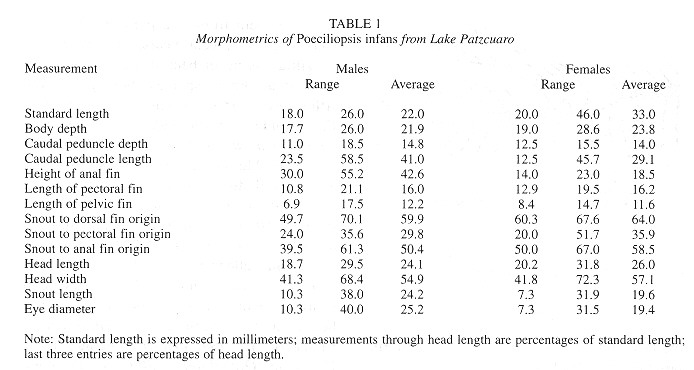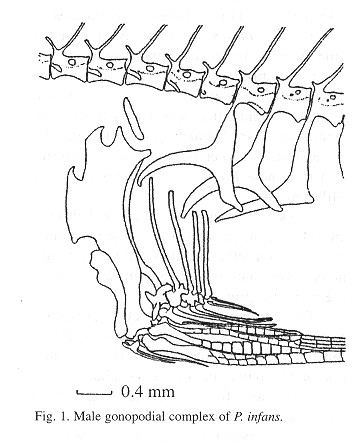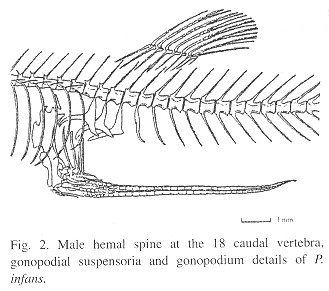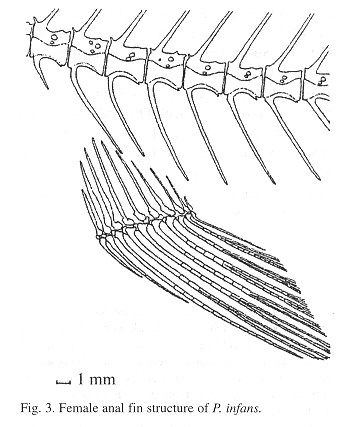Revista de Biología Tropical
versión On-line ISSN 0034-7744versión impresa ISSN 0034-7744
Rev. biol. trop vol.50 no.3-4 San José dic. 2002
Abstract
Since 1997, Poeciliopsis infans Woolman 1894 has been recognized as a new inhabitant of Lake Patzcuaro, Michoacan in Central Mexico. Between February 1997 and October 1998, nine fish samples were collected at Lake Patzcuaro. Morphometric and meristic counts were conducted on a random selection of 40 organisms of both sexes of Poeciliopsis infans. Males of these viviparous fish posses a modified anal fin called gonopodium. The characteristic hemal spine on the 18,h caudal vertebra for this species is describes herein and the bony components of the gonopodial structure and suspensorio that together comprise the gonopodial system, which is important for taxonomic studies at various levels of classification were reviewed. Poeciliopsis infans displays a high degree of sexual dimorphism in body shape and anal fin anatomy with the most conspicuous difference observed in anal fin height, which averages 40% of SI in males and 17% in females. Comparisons between male and female anal fins are describes herein as well as the possible impacts of this species on Lake Patzcuaro fish fauna.
Key words
Gonopodial suspensorio, introducted species, lake, Patzeuaro, Poeciliidae, Poeciliopsis infans.
The Poeciliinae are viviparous cyprinodonts in which the anal fin of the male is advanced and modified into an intromitent organ. The differences in structure of this organ make for a great systematic importance (Regan 1913 ).
This poeciliid species, which is describes below, has been collected in Lake Patzcuaro since February 1997. Previously, many ichthyological studies have been conducted in this geographical area (Meek 1904 , Hubbs and Turner 1939 , De Buen 1944 , 1946 , Barbour 1973 ) and many fish species lists have been published, especially within the last twenty years in which they were written (Rosas 1976 , Miller and Smith 1986 , Anonymous 1990 , Berlanga 1993 , Chacon 1993a , b , Berlanga et al. 1997 ). None of these studies or fish lists include a poeciliid as an element distinct from the local ichthyofauna.
The environmental impact of the introduction of this fish species into the aquatic ecosystem of Lake Patzcuaro has not been quantified, but it is known that in the past this system has been disrupted many times by the intentional introduction of commercial exotic species without success (De Buen 1944 , Rosas 1976 , Lara 1980 ).
The aim of this paper is to establish the new record of this poeciliid fish found in Lake Patzcuaro according to the review of the gonopodial bony structures based on previous papers describes by De Buen (1943) , Alvarez and Aguilar (1957) , Rosen and Bailey (1963) , Alvarez (1970) , Parenti (1981) and Parenti and Rauchenberg (1989) . We also discussed the possible ecological impact of the presence of this newly introduced fish from the Heterandriini tribe on Lake Patzcuaro.
Material and methods
Study site: Lake Patzcuaro belongs to an endorreic basin at the Transversal Volcanic Axis, in the Central Mesa of Mexico, located in the State of Michoacan. lt lies approximately between 19º 32'27" and 19º42'18" N latitude and between 101º 32'46" and 101º42'35" E longitude, at an elevation of 2035 m ( Anonymous 1998 ). Its main water inflow is from rainfall with additional inflows from infiltration, draining and some small springs.
Between February 1997 and October 1998, nine fish samples were collected at eight stations in Lake Patzcuaro. Fishing gear included a seine net 47.8 m long with mesh opening of 0.5 cm and a calculated trolling area of 182 m2. Samples were fixed in the field in 4% formaline solution and all poecilids were separated according to sex and stored in 70% ethanol solution.
Morphometric and meristic counts were made on a random selection of 40 organisms (21 males and 19 females) from the total sample. Twenty individuals were cleared and stained following the Alcian blue and red alizarin technique as suggested by Potthoff (1984) . Counts and proportional measurements were conducted according to Calliet (1986) . Measurements were made using Tanita, Co. digital calipers to the nearest 0. 1 mm. Measurements other than standard length (SI) are expressed as a percentage of SI, except sub-units of the head which are recorded as a percentage of the head length (H1).
Gonopodial structure was analyzed under a 5x stereomicroscope, and photographic techniques (slides).
Voucher specimens have been deposited in the National Museum of Natural History Washington, D.C. (USNM) 365565; Centro Regional de Investigación Pesquera, Patzcuaro, Mich. (CRIPATZ) 6256, 6258, 7589, 7858, 9586; University of Nuevo Leon, Monterrey, N.L. (UANL) 23566; and Instituto Politecnico Nacional, Mexico, D.F. (IPN).
The type of Gambusia infans Woolman and the lectotype of Poeciliopsis infans vouchers of the National Museum of Natural History, Smithsonian Institution, were examined to verify species through meristic and morphometric comparisons (USNM 00055871, 00117591, 00161267, 00161268, 00161269, 00161321,00245972,00245971).
Results
Averages of the morphometric measurements of males and females are presented on Table 1 . As can be seen, there are two very obvious sexual dimorphic differences, being the most conspicuous the anal fin height which averages 40% of SI in males and 17% in females. The size expressed as a standard length difference is also conspicuous. On average, males are 2/3 the size of females.
Body: Poeciliopsis infans has an elongated, terminal mouth, with a head length ratio of 25.0%, and snout to dorsal fin ratio of 61.9% The snout to pectoral fin ratio was 32.8%, snout to anal fin ratio: 54.5%, caudal peduncle depth length ratio: 35.0%, caudal peduncle depth ratio: 14.4%, length of pectoral fin ratio: 16.1%, and length of pelvic fin ratio: 11.8%; (% of SI).
Standard length (SI): the SI of P. infans ranged in average from 22.0 mm for males to 33.0 mm for females in the analyzed samples.
Fins: pectoral, pelvic, dorsal, anal and caudal fins are present in P. infans. The number of fin rays is as follows: eight in the dorsal; 12 in the pectoral; seven in the pelvic; ten in the anal; and 27 in the caudal.
Vertebrae: using cleared and stained organisms, 33 vertebrae, including urostile, were counted and divided in 13 precaudal and 20 caudal.

Gonopodial suspensorio: the following morphological description was found for gonopodial suspensorio, which consists of four elements: gonapophyses (three modified hemal spines), gonactinost, basosteas and gonopodium (Fig. 1 ).
The gonapophyses I, II, and III are attached to the caudal vertebrae 15, 16 and 17 by hemal arches. The gonapophys I present parapophyses, gonapophyis II and III present unciform processes. Hemal arches display a medium laminar shape in longitude and a bending back oriented position, which indicates that the anterior face, when inserted into the vertebrae, becomes lateral by the side of the arch. The body is as long as the parapophyses, or a little bit longer, cylindrical, and describes a half circle, laminar parapophyses, and three angles in shape, edge practically straight.

The second gonapophys presents an unciform laminar process, and is like an elongated triangle in shape with no tip at the apex. The hemal arch is like that of the first gonapophys. lt has a bigger body than that of the unciform process, which is wide at the proximal area and is slightly curved with a hollow at the anterior edge close to the apex.
The third gonapophys presents no clearly developed process, however the area between the body and the hemal arch forms an obtuse angle with a notable, sharp apex.
For this species, caudal vertebra number 18 exhibits a specific kind of spine, which is characteristic for each species. lt is caudal oriented and is as long as that of the unciform process with a back tip end.
The primary gonactinostal complex displays a distinct recess anteriorly for gonactinost one, with well-developed superior and inferior lateral wings. Larger superior wings extend outward and backward in a bluntly or sharply pointed process, incorporating gonactinosts two, three and four, and then rising upward and curving backward, forming a channel where the first free gonactinost is inserted. Gonactinost six and seven are inserted between gonapophysis one and two, while gonactinosts eight and nine are inserted between gonapophysis two and three.
The basosteas presents a cartilaginous, not bony, tissue, so it is just a condilo between the gonactinost and anal radius.
The gonopodium represent a modification of the anal fin radius, especially in number three, four, and five, which are the longest. The gonopodium tip is a hook-like structure of the tapered end. The ligastyle has a slight S-shape and is located just between vertebrae 11 and gonactinosts four and five (Fig. 2 ).

Discussion
Lake Patzcuaro is an area dominated by an endemic fish fauna in terms of abundance and variety. A total of 14 species encompassing ten genera from five families have been recognized in recent years. Nevertheless a poeciliid has never been describes before in this area. Four species belong to the Atherinidae (Chirostoma estor Jordan, Chirostoma grandocule Steindachner, Chirostoma attenuatum Meek, Chirostoma patzcuaro Meek) and six species from five genera, including Poeciliopsis, belong to the Cyprinodontidae (Goodea luitpoldi von Bayern, Allophorus robustos Bean, Allotoca diazi Meek, Skiffia lermae Meek, Skiffia multipunctata Pellegrin). So in fact, 50% of the lake fish fauna in numerical terms are livebearer organisms. The other four species belong to the Cyprinidae (Cyprinus carpio Linnaeus, Algansea lacustris Steindachner), Cichlidae (Oreochromis niloticus Linnaeus), and Centrarchidae (Micropterus salones Lacepede). This paper distinguishes Poeciliopsis infans as a newly introduced inhabitant to the above mentioned lake.
In addition to the obvious difference in length and position of the anal fin between sexes, we found differences in caudal peduncle length, snout to dorsal fin origin length, and eye and snout diameters, similar to the description of a new Poeciliopsis species made by Miller in 1975 .
Unlike the males, we could not discern any change in structure in the female body conformation, although they have a cartilaginous pterigiophorus process at the inner end of their anal fin (Fig. 3 ).

The 18th male caudal vertebrae presents a cylindrical back curved tip process spine as long as the gonapophyses III. This structure does not belong to the suspensorio but is a distinctive element for cach species as describes by Alvarez and Aguilar (1957) .
Among poeciliids in Central Mexico, Miller and Smith (1986) reported six species in three genera. Generally, Poeciliopsis inhabits water bodies located at low altitudes on the Pacific slope, and just one species, P. infans, has an extended distribution in the Mexican Central Mesa. In this genus, one of the most important characteristics for identification purposes is the distribution boundaries due to the fact that they are very well established.
The closest locality to Lake Patzcuaro where a permanent presence of poeciliids is cited is Lake Cuitzeo, which is located in the basin next to the Patzcuaro hasin. In 1941, P infans was collected at Rio Grande de Morelia by De Buen, and in a hot spring at Cointzio, near Morelia City by Alcantar (De Buen 1943 ). These events show the possible unexpected move of the species up to Lake Patzcuaro from the Cuitzeo basin. The gradual extension of distribution limits is a common characteristic of poeciliids, P. infans, which gradually moves up to Lake Patzcuaro, which becomes a new settling area.
Nineteen species of poeciliids have been reported as introduced beyond their previously known historical ranges. Their ability to survive and successfully establish reproducing populations in alien warm water ecosystems probably is paralleled only by certain cichlids (particularly tilapiines) and some cyprinids and salmonids in colder waters. For many poeciliids, the ability to not only survive but to succeed has been spectacular, even in the presence of predators (Courtenay and Meffe 1989 ).
There are two major factors resulting in broad habitat use by poeciliids. First, they are excellent colonizers; a single gravid female can found a new population due to superfetation ( Parenti 1998 ). Second, this kind of fish typically inhabits shallow waters, often partially or heavily vegetated (Meffe and Snelson 1989 ). Matrotrophic maternal provisioning could also be another factor of success (Reznick and Miles 1989 ).
Possible forins of introduction could have been the release of the organism by an aquarist, or through the extension of activities of some of the many groups that work with the fish fauna or the aquatic resources of the area. Some specimens could have even reached small springs at the top of the mountains, which divided the basins of Patzcuaro and Cointzio on their own or through floods, which may have carried this fish up to Lake Patzcuaro by drainage.
There have been few investigations on the impact of introduced fish on native fish and aquatic habitats in Mexico. The Mexican government is understandably concerned with the low protein diet of many Mexicans, particularly of people living in rural areas. The government, therefore, measures success of introduced fish in economic and social terms and not in terms of their real or potentially adverse impact to native biota or habitats (Contreras and Escalante 1984 ).
Most of the negative impacts of introduced poeciliids appear to involve predation, behavioral interactions, introduction of parasites and disease, habitat disruption, competition, even for trophic resources or space and for breeding and nursery areas during reproduction periods. So this live-bearer must be monitored to estimate its potential impact on this closed aquatic ecosystem.
Acknowledgments
This research was conducted with grants-in-part from the National Council of Science and Technology, Mexico. Our most sincere gratitude lo Lynne Parenti (Curator, NHNM, U.S.A.), Susan Jewett (Fish collection manager at NHNM, U.S.A.), Porfirio Alvarez T. (Aquaculture Research Division. Director, INP, México), and Araceli Orbe M. (Top head, Crip-Pátzcuaro, México). Draws were done by Abraham Kobelkowsky (Professor, UAM-I, Mexico). Finally, lo all the colleagues who made any correction or comment to the original manuscript.
Resumen
A partir de Febrero de 1997 la especie Poeciliopsis infans Woolman 1894 es reconocida como un habitante más en las aguas del Lago de Pátzcuaro, el cual se sitúa en la meseta central mexicana. Nueve colectas ictiológicas se efectuaron en este lago dentro del periodo comprendido entre febrero de 1997 y octubre de 1998. Conteos meristicos y mediciones morfométricas se efectuaron en 40 organismos de ambos sexos seleccionados al azar. Los machos de esta especie presentan una aleta anal modificada que recibe el nombre de gonopodio. En este artículo se llevo a cabo una revisión y se describe la dieciochoava espina hemal que es una característica única de esta especie así mismo se describe el sistema gonopódico el cual está comprendido por la estructura gonopodial y el suspensorio. P. infans muestra un alto grado de dimorfismo sexual tanto en la forma del cuerpo como en la anatomía de la aleta anal, la diferencia más conspicua fue observada en la altura de dicha aleta la cual promedia 40% y 17% de la longitud furcal para machos y hembras respectivamente. Se hace una descripción de las comparaciones efectuadas en los dos sexos sobre la aleta anal y se discuten los posibles impactos ecológicos que esta especie podría generar sobre el resto de la ictiofauna que habita el lago de Pátzcuaro.
References
Alvarez, J. 1970. Peces Mexicanos (Claves). Instituto Nacional de Investigaciones Biológico-Pesqueras. Secretaría de Industria y Comercio, México, D.E 166 p. [ Links ]
Alvarez, J. & E Aguilar. 1957. Contribución al estudio de la suspensión gonopódica del género Poeciliopsis con una descripción de una nueva especie fósil procedente de El Salvador, Centro América. Rev. Soc. Méx. Hist. Natur. 18 (1-4): 153-171. [ Links ]
Anonymous. 1990. Situación actual y perspectivas de las pesquerías derivadas de la acuicultura. Secretaria de Pesca. México, D.F. 78 p. [ Links ]
Anonymous. 1998. Nomenclator para el estado de Michoacán. Instituto Nacional de Estadística Geografia e Informatica México, D.E 378 p.
Barbour, C.D. 1973. The systematic and evolution of genus Chirostoma Swainson (Pisces: Atherinidae), Tulane Stud. Zool. Bot. 18: 3-141. [ Links ]
Berlanga, R.C.A. 1993. Contribución al conocimiento de las comunidades de peces del Lago de Pátzcuaro, Michoacán. Tesis de Licenciatura. Universidad Nacional Autonoma de México, D.E, México. 91 p.
Berlanga, R.C.A., L.A. Ruiz, VM.R. Nepita & VJ. Madrid. 1997. Estabilidad y diversidad de la composición de peces del Lago de Pátzcuaro, Michoacán, México. Rev. Biol. Trop. 45: 1553-1558. [ Links ]
Caillict, M.G., M.S. Love & A.W. Ebeling. 1986. Fishes. A field and laboratory manual on their structure, identification, and natural history. Wadsworth. Belmont, California. U.S.A. 194 p. [ Links ]
Chacon, T.A. 1993a. Lake Patzeuaro, Mexico: watershed and water quality deterioration in a tropical high-altitude Latin American lake. Lake Res. Man. 8: 37-47. [ Links ]
Chacon, T.A. 1993b. Pátzcuaro un lago amenazado. Bosquejo limnologico. Universidad Michoacana de San Nicolas de Hidalgo. Universitaria. México. pp. 8-1 1. [ Links ]
Contreras, B.S. & M.A. Escalante. 1984. Distribution and known impacts of exotic fishes in Mexico. pp. 102-130 . In W.R. Jr Courtenay & J.R. Jr. Stauffer (eds.). Distribution, Biology and Management of Exotic Fishes. Hopkins. Baltimore, U.S.A. [ Links ]
Courtenay, W.R. Jr & G.K. Meffe. 1989. Small Fishes in Strange Places: A Review of Introduced Poeciilids pp. 319-331 In G.K. Meffe & F.E Jr. Snelson (eds.). Ecology and Evolution of Livebearing Fishes, (Poeciliidae). Prentice-Hall, New Jersey, U.S.A. [ Links ]
De Buen, F. 1943. Poeciliopsis en las cuencas de los ríos Lerma y Marqués, con descripción de dos nuevas especies (Pisces-Poeciliidae). An. Ins. Biol. Méx. 14: 261-283. [ Links ]
De Buen, E 1944. Limnobiología del Lago de Pátzcuaro. An. Inst. Biol. Méx. 15: 261-312. [ Links ]
De Buen, E 1946. Ictiogeografía Continental Mexicana (1, 11 y 111). Rev. Soc. Mex. Hist. Nat. 7: 87-138. [ Links ]
Hubbs, C.L. & C.L. Turner. 1939. Studies of the fishes of the order Cyprinodontes. XVI. A revision of the Goodeidae. Misc. Pub. Mus. Zool. Univ. Mich. 42: 1-80. [ Links ]
Lara, A. 1980. Introducción de nuevas especies al lago de Pátzcuaro y su posible perjucio a las especies nativas. 11º Simposio Latinoamericano de Acuicultura. Secretaria de Pesca, México, D.E Vol. 1. 727 p. [ Links ]
Meffe, G.K. & F.E Jr. Snelson. 1989. An Ecological Overview of Poeciliid Fishes. pp. 13-31. In G.K. Meffe & F.F. Jr. Snelson. (eds.). Ecology and Evolution of Livebearing Fishes, (Poeciliidae). Prentice-Hall. New Jersey, U.S.A. [ Links ]
Meek, S.E. 1904. The fresh-water fishes of Mexico north of the isthmus of Tehuantepec. Field Col. Mus. Pub.93. (Zool.) 5: 1-252. [ Links ]
Miller, R.R. 1975. Five new species of Mexican poeciliid fishes of die genera Poecilia Gambusia and Poeciliopsis. Oc,c. Pap. Mus. Zool. Univ. Mich. 672: 1-44. [ Links ]
Miller, R.R. & L. Smith. 1986. Origins and Geography of the Fishes of Central Mexico. pp. 487-517. In C.H. Hocutt & E.0. Wiley (eds.). The Zoogeography of North American freshwater fishes. Wiley. New York, U.S.A.
Parenti, L.R. 1981. A phylogenetie and biogeographic analysis of Cyprinodontiform fishes (Teleostei, Atherinomorpha). Bull. Am. Mus. Nat. Hist. Vol. 168: 341-557. [ Links ]
Parenti, L.R. 1998. Killifishes and Ricefishes pp. 148-152. In J.R. Paxton & W.N. Eschmeyer (eds.). Encyclopedia Fishes of the World. Academic. San Diego, U.S.A. [ Links ]
Parenti, L.R. & M. Rauchenberg. 1989. Systematic Overview of the Poeciliines. pp. 3-12. In G.K. Meffe & F.F. Jr. Snelson (eds.) Ecology and Evolution of Livebearing Fishes, (Poeciliidae). Prentice-Hall, New Jersey, U.S.A. [ Links ]
Potthoff, T. 1984. Clearing and Staining Techniques. pp. 35-37. In American Society of Ichthyologists and Herpetologists (eds.). Ontogeny and Systematic of Fishes. Special publication N' 1. Amer. Soc. Ichthyol. Herpet. Allen. New York, U.S.A, [ Links ]
Reznick, D.E. & D.B. Miles. 1989. Review of Life History Patterns in Poeciliid Fishes. pp. 125-148. In G.K, Meffe & F.F. Jr. Snelson (eds.). Ecology and Evolution of Livebearing Fishes, (Poeciliidae). Prentice-Hall. New Jersey, U.S.A. [ Links ]
Regan, C.T. 1913. A revision of the Cyprinodont Fishes of the Subfamily Poeciliinac. Proc. Zool. Soc. London, 2: 977-1018. [ Links ]
Rosas, M. 1976. Datos biológicos de la ictiofauna del lago de Pátzcuaro, con especial énfasis en la alimentación de sus especies. 1er Simposio sobre Pesquerías en Aguas Continentales. Instituto Nacional de la Pesca, México, D.E 489 p. [ Links ]
Rosen, D.E. & R.M. Bailey. 1963. The Poeciliid fishes (Cyprinidontifomies), their structure, zoogeography and systematics. Bull. Am. Mus. Nat. Hist. 126: 116-139. [ Links ]
1 . Kochi University, B 200 Monobe, Nankoku-shi. Kochi-ken. 783-0093 Japan.
2 . Regional Fisheries Rescarch Center-Patzcuaro, Ibarra #28, Col. Ibarra Pátzcuaro, Michoacán. México. Tel/Fax: (81) (088) 864-5158; mailto:jgalindo@cc.kochi-u.ac.jp












 uBio
uBio 

